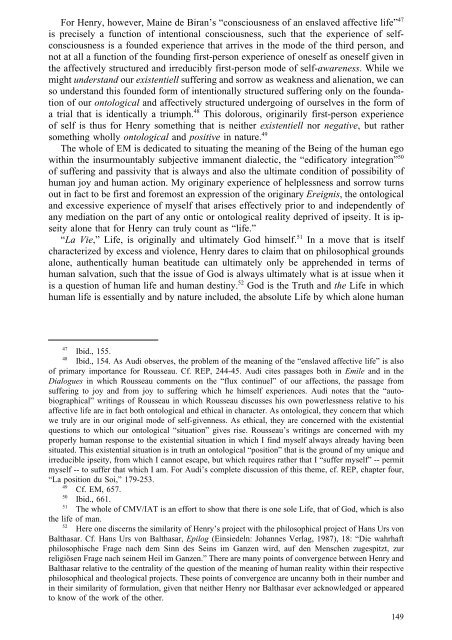[Andrzej_Wiercinski_(ed ... - WordPress.com
[Andrzej_Wiercinski_(ed ... - WordPress.com
[Andrzej_Wiercinski_(ed ... - WordPress.com
You also want an ePaper? Increase the reach of your titles
YUMPU automatically turns print PDFs into web optimized ePapers that Google loves.
For Henry, however, Maine de Biran’s “consciousness of an enslav<strong>ed</strong> affective life” 47is precisely a function of intentional consciousness, such that the experience of selfconsciousnessis a found<strong>ed</strong> experience that arrives in the mode of the third person, andnot at all a function of the founding first-person experience of oneself as oneself given inthe affectively structur<strong>ed</strong> and irr<strong>ed</strong>ucibly first-person mode of self-awareness. While wemight understand our existentiell suffering and sorrow as weakness and alienation, we canso understand this found<strong>ed</strong> form of intentionally structur<strong>ed</strong> suffering only on the foundationof our ontological and affectively structur<strong>ed</strong> undergoing of ourselves in the form ofa trial that is identically a triumph. 48 This dolorous, originarily first-person experienceof self is thus for Henry something that is neither existentiell nor negative, but rathersomething wholly ontological and positive in nature. 49The whole of EM is d<strong>ed</strong>icat<strong>ed</strong> to situating the meaning of the Being of the human egowithin the insurmountably subjective immanent dialectic, the “<strong>ed</strong>ificatory integration” 50of suffering and passivity that is always and also the ultimate condition of possibility ofhuman joy and human action. My originary experience of helplessness and sorrow turnsout in fact to be first and foremost an expression of the originary Ereignis, the ontologicaland excessive experience of myself that arises effectively prior to and independently ofany m<strong>ed</strong>iation on the part of any ontic or ontological reality depriv<strong>ed</strong> of ipseity. It is ipseityalone that for Henry can truly count as “life.”“La Vie,” Life, is originally and ultimately God himself. 51 In a move that is itselfcharacteriz<strong>ed</strong> by excess and violence, Henry dares to claim that on philosophical groundsalone, authentically human beatitude can ultimately only be apprehend<strong>ed</strong> in terms ofhuman salvation, such that the issue of God is always ultimately what is at issue when itis a question of human life and human destiny. 52 God is the Truth and the Life in whichhuman life is essentially and by nature includ<strong>ed</strong>, the absolute Life by which alone human47Ibid., 155.48Ibid., 154. As Audi observes, the problem of the meaning of the “enslav<strong>ed</strong> affective life” is alsoof primary importance for Rousseau. Cf. REP, 244-45. Audi cites passages both in Emile and in theDialogues in which Rousseau <strong>com</strong>ments on the “flux continuel” of our affections, the passage fromsuffering to joy and from joy to suffering which he himself experiences. Audi notes that the “autobiographical”writings of Rousseau in which Rousseau discusses his own powerlessness relative to hisaffective life are in fact both ontological and ethical in character. As ontological, they concern that whichwe truly are in our original mode of self-givenness. As ethical, they are concern<strong>ed</strong> with the existentialquestions to which our ontological “situation” gives rise. Rousseau’s writings are concern<strong>ed</strong> with myproperly human response to the existential situation in which I find myself always already having beensituat<strong>ed</strong>. This existential situation is in truth an ontological “position” that is the ground of my unique andirr<strong>ed</strong>ucible ipseity, from which I cannot escape, but which requires rather that I “suffer myself” -- permitmyself -- to suffer that which I am. For Audi’s <strong>com</strong>plete discussion of this theme, cf. REP, chapter four,“La position du Soi,” 179-253.49Cf. EM, 657.50Ibid., 661.51The whole of CMV/IAT is an effort to show that there is one sole Life, that of God, which is alsothe life of man.52Here one discerns the similarity of Henry’s project with the philosophical project of Hans Urs vonBalthasar. Cf. Hans Urs von Balthasar, Epilog (Einsi<strong>ed</strong>eln: Johannes Verlag, 1987), 18: “Die wahrhaftphilosophische Frage nach dem Sinn des Seins im Ganzen wird, auf den Menschen zugespitzt, zurreligiösen Frage nach seinem Heil im Ganzen.” There are many points of convergence between Henry andBalthasar relative to the centrality of the question of the meaning of human reality within their respectivephilosophical and theological projects. These points of convergence are uncanny both in their number andin their similarity of formulation, given that neither Henry nor Balthasar ever acknowl<strong>ed</strong>g<strong>ed</strong> or appear<strong>ed</strong>to know of the work of the other.149


